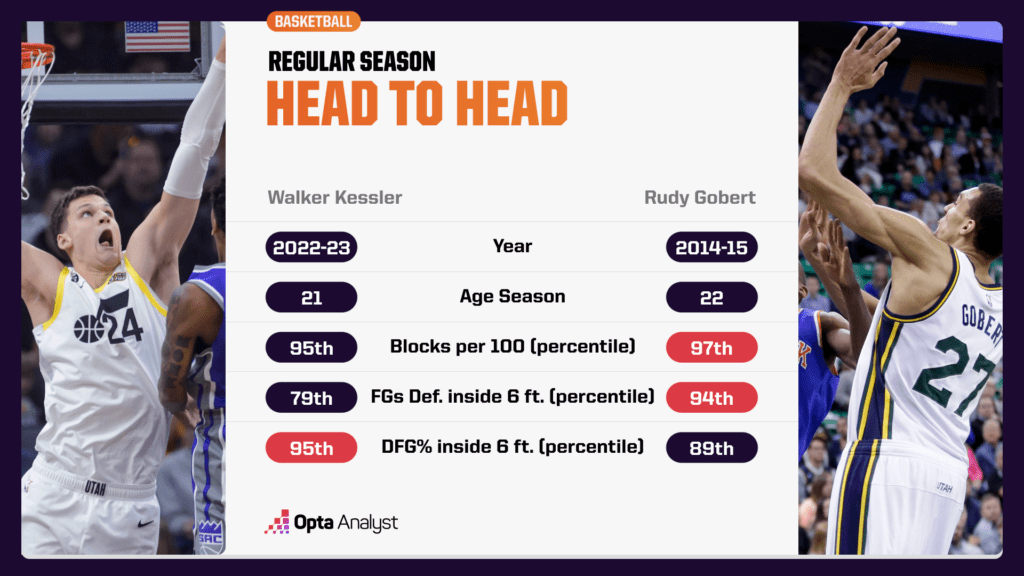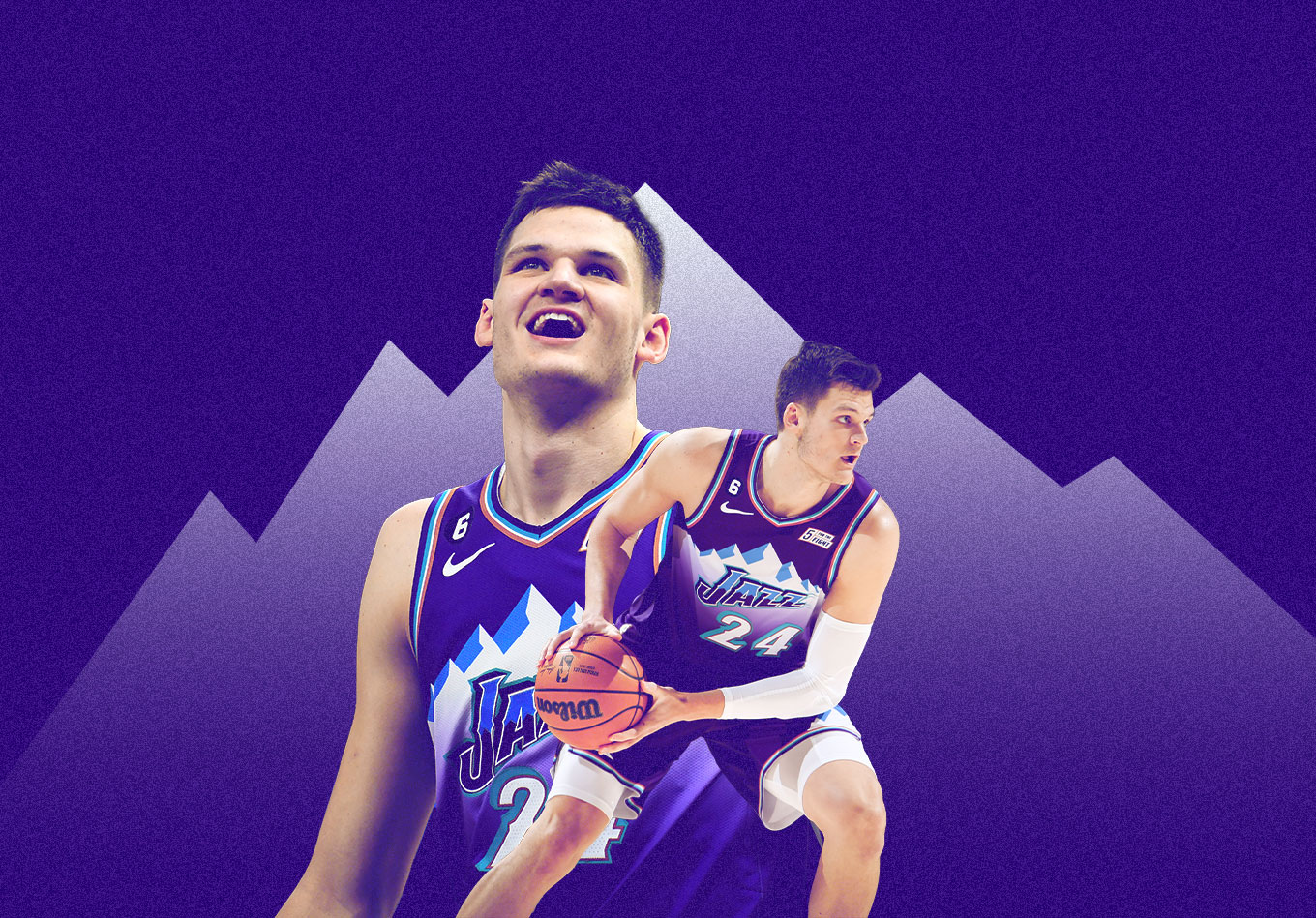When the Utah Jazz traded away their two franchise cornerstones, Rudy Gobert and Donovan Mitchell, they dug their own grave, and they knew it too. And as a result,they were prepared for a grim 2022-23 campaign.
Flash forward to the end of March, and while the team appears to have bowed out of the playoff race, they were in the hunt until they decided they didn’t want to be anymore.
Lauri Markkanen deserves the lion’s share of the credit for the team’s success this season, as his first campaign in Utah marked his ascension into Lauri Legend.
But as the old adage goes, “no man is an island,” and Markkanen’s crusade was no different. His mission was aided by the surprise play of rookie big man Walker Kessler. In fact, Kessler has been so good that he’s risen to third in Rookie of the Year odds and is garnering comparisons to the watchful guardian who captained the Jazz’s interior defense for nearly a decade.
But is such praise really warranted? Is this just another case of fans getting too excited about the unknown potential of a young prospect? Or is Kessler Walker really as good as the generational defender his advocates compare him to?
The Good
In his research for the book “Basketball Analytics: Spatial Tracking,” Dr. Stephen Shea deduced that a team’s ability to protect the rim was the most influential factor that contributed to a team’s defensive rating.
To frame it in simpler terms, the better your team is at protecting the rim, the better chance they have at being good at defense. And if you never heard the saying “no man is an island,” you surely have heard the maxim that “defense wins championships.”
Anyway, despite not even being 82 games into his NBA career, Kessler is already one of the premier rim protectors in basketball.
There are two major keys to his proficiency in this area. First, he’s massive (7’1, 245 pounds, per Basketball Reference), and being a large object is incredibly helpful when it comes to safeguarding the paint.
For the second key, think of it this way. We all have that friend who always seems to be picking up dates. But how do they do it? Simple. They are always at every social function. The more darts you have to throw, the better chance you have of hitting a bullseye.
It’s the same way with Kessler. He’s always at the dance. And by dance, we mean the painted area. Like Brook Lopez, Kessler has mastered the subtle tricks for navigating the 2.9 area without being called for a defensive three-second violation.
On top of that, Coach Will Hardy and the Jazz typically deploy Kessler in a deep drop coverage to enable him to stay close to the paint and protect their inner shell from any potential threats.
(Sidebar: A minor nitpick, but Kessler can be a bit too eager to contest shots at times. So much so that he’s prone to biting on pump fakes.)
Kessler is in the 95th percentile in blocks per 100 possessions among centers (minimum 25 games played). But hey, any tall guy can swat shots. The real elite defensive anchors are the ones who can deter would-be penetrators from attempting those shots altogether.
No matter how well you smother someone, if that shot goes up and it isn’t blocked, there’s a chance that it goes through the cylinder, and then all your hard work will be for nothing. So, the best practice is to make sure that shot around the rim never even exists.
Does Kessler have this element to his rim protection? Why don’t we just ask All-Stars Jimmy Butler, Jaylen Brown, and Anthony Edwards to testify on the matter.
This trio of slashers has built up a reputation as some of the most fearless drivers in the game, and that reputation went right out the window when they looked up and saw Utah’s Gedo Statue standing in their path.
He’s also able to contest a high volume of shots without fouling himself out of games. His 4.8 fouls per 100 possessions is the exact same rate as the Minnesota Timberwolves current starting center (hint: the other name in the title!).
Kessler accomplishes this feat by contesting shots vertically with both his hands straight up. That way, referees can clearly see that he isn’t initiating contact with either his body or arms. This is a smart tactic, but it does come with a tradeoff of limiting his steal rate (19th percentile among centers in steals per 100, per NBA.com).
(Sidebar: The all-time great defensive big men, like Anthony Davis and Hakeem Olajuwon, use a contest technique where they put one arm up vertically and leave the other one on the side to try and deflect/intercept any laydown passes, like this).
Kessler’s massive defensive impact is evident in both his numbers and his team’s stats. Among players with at least 1000 minutes this season, Kessler is in the 93rd percentile in our defensive DRIP metric (our catch-all metric, which projects a player’s contribution to a team’s plus-minus per 100 possessions).
On a team-wide level, the Jazz were 30th in the league in points in the paint per 100 (54.8) before Kessler became a full-time starter on January 10th. Since that date, Utah is now 15th in the league in that statistic (49.9) during that time span. And that’s despite losing defensive ace Jarred Vanderbilt at the trade deadline.
Offensively, his contributions aren’t nearly as impactful. But he does provide value with his offensive rebounding (91st percentile in contested ORB% among centers), cutting instincts (often cutting from the corner like a slashing guard), and interior play-finishing (99th percentile scoring efficiency).
The Bad
By all accounts, Kessler is already a top-tier drop defender in the league. The problem is that he plays in the Space Ball era of the NBA, and here they have figured out a handful of methods to mitigate the effectiveness of traditional rim protectors like himself.
In the next clip montage, you’ll see three ways teams can “expose” a drop big man.
- First Clip: If the point-of-attack defender does a poor job navigating the screen (which often happens because Utah doesn’t have many great perimeter defenders), Kessler is left vulnerable to a pull-up jumper.
- Second Clip: Since Kessler is usually jockeying for putbacks on the offensive side of the court, if you push the pace swiftly enough, you can get into the paint before he even has a chance to set up shop down there.
- Third Clip: You can have a three-point shooting big man set a screen and pop out instead of roll. And since Kessler is sagging into the paint, he won’t be able to offer an adequate contest on the shooter.
You can also attack these big men by inducing them to switch into an unfavorable mismatch, but to their credit, Utah has hardly allowed instances like that to take place. And when they have transpired, Kessler has shown to be a bit more nimble than one would imagine.
Of course, Utah faithful are very much familiar with the drawbacks of having this kind of big man in the playoffs. And while this defensive style does pose some serious limitations in a postseason setting, people tend to forget that it was often Gobert’s lack of offense that usually got him “played off the court.”
Unfortunately, Kessler is similar to his progenitor in this way too. In today’s game, if you don’t have a unicorn offensive center (think Nikola Jokic and Joel Embiid), you want the person occupying your five spot to be either a dual play-finisher (someone who can catch lobs and hit threes, like Jaren Jackson Jr.) or a credible dribble handoff engine (like Domantas Sabonis or Bam Adebayo).
Kessler can finish around the rim, but he’s a non-shooter at this point, and his free throw percentage (52.2%) indicates that it will remain that way for the foreseeable future.
Coach Hardy tries to involve him as a facilitator in the short roll or on handoff actions, but his delivery accuracy and processing speed pale in comparison to the cache of splendid big-man passers who exist in today’s NBA landscape.
The Outlook
Back to our original question about the merit of claims comparing Sky Walker to the Stifle Tower. If you compare Kessler’s rim-protecting numbers to those of Rudy Gobert’s during his second season in the league (he only played 434 minutes as a rookie), you’ll notice the two share an eerily similar statistical profile.

By all accounts, it appears that the stories are true and that Kessler is well on his way to being one of the best (if not the best) traditional rim protectors of his era. Utah has its new Gobert.
But what does that mean for him impact-wise?
The league has evolved rapidly this year. More so than ever, individual offense stands out more than individual defense, meaning it is harder to be an All-Star caliber player as a defensive-oriented player – even if you’re a big man. Just look at a guy like Jarrett Allen not making an All-Star team this year, despite making it last year and showing no signs of decline in his game.
The only defensively-slanted bigs who made an All-Star team this year were Jackson and Adebayo. Both of these guys fill the offensive needs we mentioned earlier and provide more versatility than classic centers like Gobert and Kessler.
At this rate, if Kessler does fulfill his promise and reach Gobert-esque status, it’s possible that Gobert-esque status looks more like a top-50 player in the mid/late 2020s than the All-NBA force that the Stifle Tower was at his peak.
However, there is a quiet storyline to monitor as the season comes to a close. Over the last few weeks, the Jazz have been experimenting with more exotic zone defenses that are designed to keep Kessler near the paint.
And while this specific zone alignment has a gimmicky/unsustainable quality to it (particularly in that it leads to a ton of open corner threes), if it somehow manages to unlock a trend of defensive coverages that are designed to keep rim protectors glued to the paint without the tradeoffs that exist with the current practices, it could re-establish the value of the traditional defensive anchor.
And if that happens, and Kessler continues to grow at the rate he’s projected to, the Utah Jazz might have just replaced their former Defensive Player of the Year with a future one.
